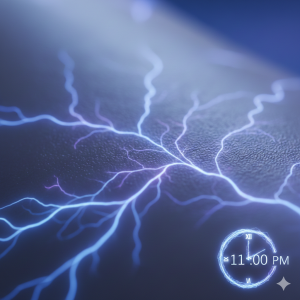In my years of practice, I’ve found that while everyone knows they should manage their stress, very few people have a toolbox that goes beyond the usual advice to “just meditate.” While mindfulness is a fantastic practice, I want to let you in on two of my favorite, yet often overlooked, secret weapons for destressing: hydrotherapy and chromotherapy.
Think of these as powerful, science-backed tools you can use right in your own home. They go beyond simply calming the mind; they create real, physiological changes in your body that actively combat the effects of a stressful day. Let’s dive in.
Hydrotherapy: The Healing Power of Water 💧
At its core, hydrotherapy is the use of water, in its various forms and temperatures, to relieve discomfort and promote well-being.1 It’s an ancient practice, but modern science helps us understand why it works so well. When you’re stressed, your body is flooded with the hormone cortisol, your muscles tighten, and inflammation can set in. Hydrotherapy directly counteracts this.
The magic lies in how your blood vessels react to temperature changes. Warm water is a vasodilator, meaning it causes your blood vessels to expand.2 This increases the flow of oxygen-rich blood to your tired muscles, helping them relax and flushing out metabolic waste. Conversely, cold water is a vasoconstrictor, narrowing your blood vessels.3 This process can reduce inflammation, tighten skin, and give your nervous system an invigorating jolt.
Your Actionable Hydrotherapy Plan:
- The Contrast Shower: This is my top recommendation for a morning energy boost or to shake off the mental fog after a long day. It’s a game-changer for circulation.
- How to do it: Start with three minutes of hot water, as warm as you can comfortably stand. Then, switch the water to pure cold for one minute. The initial shock will pass! Repeat this hot-cold cycle three to five times, always ending on cold.
- The benefit: This rapid expansion and contraction of your blood vessels acts like a pump for your circulatory system, helping to reduce inflammation and leave you feeling incredibly refreshed and alert.
- The Prescribed Epsom Salt Bath: This isn’t just about bubbles and relaxation; it’s a therapeutic treatment. Epsom salt is magnesium sulfate, and magnesium is a critical mineral for muscle relaxation and nerve function that gets depleted under stress.4
- My prescription: Add two generous cups of Epsom salts to a warm bath (around 38∘C or 100∘F). Soak for a solid 20 minutes, two to three times a week. For an added calming effect, add 5-10 drops of lavender essential oil.
- A quick case study: I had a patient, a lawyer named Sarah, who suffered from chronic tension headaches and neck pain. She was skeptical, but I convinced her to trade her quick evening showers for three prescribed Epsom salt baths per week. Within a month, she reported that her headaches had reduced by half and the persistent knot in her shoulder had finally released its grip. She was using the power of transdermal magnesium absorption to calm her overworked muscles.
Chromotherapy: Healing with Color and Light 🌈
Now, let’s pair our water therapy with its perfect partner: light. Chromotherapy, or color therapy, is the practice of using specific colors of light to influence your mood and body.5 Each color is a different wavelength of visible light, and our brains and bodies are hardwired to respond to them differently.
While it may sound a bit “new age,” the principle is firmly rooted in science. We all know how a bright, sunny day can lift our spirits. We also know how the blue light from our phone screens can disrupt our sleep by suppressing the sleep hormone melatonin.6 We can harness this power intentionally. For destressing, we focus on the calming end of the spectrum.
- Blue: This color is associated with calm, serenity, and peace.7 It can help lower blood pressure and slow your heart rate.8 It’s the color of a clear sky or a tranquil ocean.
- Green: Deeply connected to nature, green is a balancing and harmonizing color.9 It’s restful for the eyes and has been shown to reduce anxiety.
Your Actionable Chromotherapy Plan:
- Curate Your Sanctuary: You don’t need a fancy setup. The easiest entry point is to replace your standard bathroom lightbulb with a color-changing smart bulb. These are widely available and can be controlled from your phone. Before your evening bath or shower, switch the light to a deep, calming blue or a soft, forest green. This simple act transforms your bathroom from a functional space into a genuine sanctuary.
- The “Blue Hour” Wind-Down: Combining these therapies is where the real magic happens. Let’s design the ultimate destressing ritual.
- The Ritual: An hour before you plan to sleep, prepare your prescribed Epsom salt bath. Switch your bathroom light to a serene blue. As you soak, focus on the color and allow its calming properties to wash over you along with the warm water. After your 20-minute soak, you can even perform a mini-contrast rinse (a quick 30-second blast of cold water). Then, dry off and move to your bedroom, where you should only have dim, warm-toned light (like amber or red) to encourage melatonin production for a deep, restorative sleep.
- A quick case study: Mark, a client struggling with work anxiety, found it impossible to switch off at night. His mind would race for hours. We implemented the “Blue Hour” ritual. The combination of the magnesium bath to physically relax his body and the blue light to mentally signal a state of calm was transformative. He reported that this ritual became a powerful psychological trigger, telling his brain and body that the day was over and it was time to rest. His sleep quality improved dramatically within two weeks.
Think of your bathroom not merely as a place to get clean, but as your personal wellness spa. By consciously using the fundamental elements of water and light, you’re not just pampering yourself—you are taking direct, powerful, and proactive control over your body’s stress response. Give it a try.




